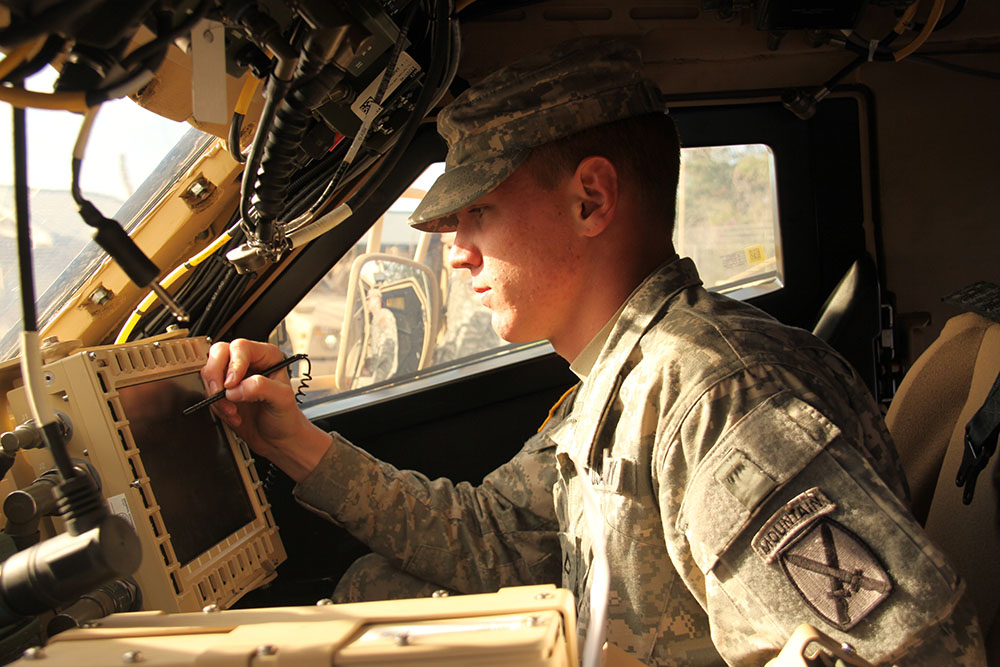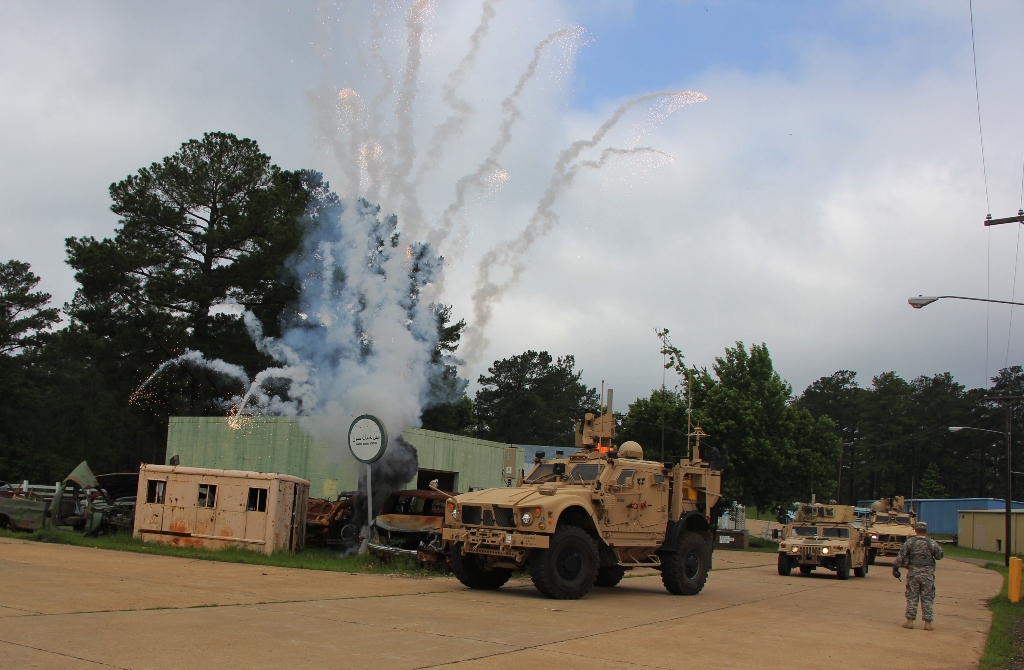
By Claire Heininger and Amy Walker, U.S. Army
ABERDEEN PROVING GROUND, Md. (Aug. 19, 2013) — The Army’s new, mobile tactical communications network has reached Afghanistan, where U.S. forces are relying on the technologies to stay connected and cover more ground.
From tracking the progress of small groups of Soldiers at remote outposts to directing operations while traveling through mountainous terrain, the unit is leveraging Capability Set 13, or CS 13, to communicate and carry out its advise-and-assist missions in support of the Afghan National Security Forces.
“The enhanced situational awareness given to us by this suite of technology has allowed us to maintain a ‘digital guardian angel’ as we conduct our advising duties and missions,” said Maj. Gary Pickens, the communications officer for the 4th Brigade Combat Team, 10th Mountain Division, which is the first unit to deploy CS 13 in theater. “The various platforms of CS 13 give us a digital reach like we’ve never had before.”

A simulated explosion at a mock Afghan village was part of a training mission thread for the 3rd Brigade Combat Team, 10th Mountain Division (Light Infantry), at the Joint Readiness Training Center at Fort Polk, La., earlier this summer, in preparation for the unit’s deployment. The WIN-T Increment 2 Soldier Network Extension-equipped vehicle (front center) enabled Soldiers to relay information throughout the brigade and increase operational tempo. The unit will join the 4th BCT, 10th Mountain Division, in theater this fall, where both BCTs will use CS 13 in support of their advise-and-assist and retrograde missions. (Photo Credit: JRTC Public Affairs)
The technology, an integrated group of tactical communications systems that came together through the Army’s Network Integration Evaluation, or NIE, process, arrived in Afghanistan with the BCT this summer, and has supported multiple missions during the last several weeks. While it is still early in their deployment, users say CS 13 is a significant improvement over previous equipment and will become even more critical as drawdown operations accelerate.
As U.S. forces continue to retrograde, they are closing many of their forward operating bases , known as FOBs, and removing communications infrastructure such as hard lines, towers and other equipment. With CS 13, select units that remain will still have the ability to communicate at the tactical level and exchange voice and data information across their entire area of operations.
“We can maintain a robust communications capability even while the infrastructure around us on FOBs collapses,” Pickens said. “With anything new, it takes time to fully understand the capability — both its opportunities and its deficiencies. CS 13 is a significant step in the right direction to enable mission command at all echelons and across all environments.”
The 4th BCT will be joined in theater this fall by the 3rd BCT, 10th Mountain Division, which has also been fielded with Capability Set 13. Both Infantry Brigade Combat Teams have reorganized into Security Force Assistance Brigades, which deploy with fewer personnel than a typical BCT, and work closely with the Afghan forces in mobile, dispersed operations — making network connectivity even more important.
CS 13 provides the Army’s first integrated communications capability across the entire BCT formation, empowering commanders and Soldiers at every echelon to make faster, better informed decisions. Through its tactical network backbone, Warfighter Information Network-Tactical, or WIN-T, Increment 2, it provides mission command “on the move” — allowing leaders to expand their reach on the battlefield by taking the network with them in their vehicles.

Soldiers with the 4th Brigade Combat Team, 10th Mountain Division, train using the Capability Set 13 communications network at Fort Polk, La., this spring. The technology, an integrated group of tactical communications systems that came together through the Army’s Network Integration Evaluation process, arrived in Afghanistan with the BCT this summer, and has supported multiple missions during the last several weeks. (Photo Credit: SSG Kulani Lakanaria, 4th BCT, 10th Mountain Division)
In Afghanistan, this capability has allowed battalion-level advising teams to exchange voice and data, access mission command systems and maintain situational awareness while on patrols, even in extremely difficult terrain.
“Communicating on the move is a significant step,” Pickens said. “What we have seen is that unlike in the past, [when] as commanders transitioned from their command post to mounted operations an information gap arises; with the capabilities of WIN-T Increment 2 and supporting applications this gap isn’t as large and not as disruptive to maintaining a commander’s rhythm.”
CS 13 also extends the network to the Soldier level through a combination of smartphone-like Nett Warrior “End User Devices,” or EUDs, and Rifleman Radios that together can transmit text messages, GPS locations and other data. This empowers dismounted troops with the real-time information that previously was only available in vehicles or command posts. It also allows the BCT headquarters and battalion and company leadership to digitally track and communicate with Soldiers who have spread out to remote locations — even inside distant buildings — as they advise their Afghan partners.
“Previously, voice reporting over FM radio was the only communications link to Soldiers in these scenarios,” Pickens explained. “The EUDs come in very handy not only for situational awareness of the operator’s position and those of his fellow Soldiers, but also their ability to carry information.”
Built on Soldier feedback, CS 13 addresses more than 55 operational needs statements that troops submitted from Iraq and Afghanistan. The package was integrated, refined and validated through the NIEs, the Army’s process to continually mature the tactical network and accelerate and improve the way communications technologies are delivered to Soldiers.
The capability set’s arrival in Afghanistan is the culmination of a total Army effort to quickly field the technologies, spanning dozens of commands and locations and requiring constant coordination among network and vehicle project managers, production facilities, brigade staffs, fielding personnel and training professionals. Fielding and training operations are now underway for two more brigades — the 2nd and 3rd BCTs of the 101st Airborne Division (Air Assault). The 101st Airborne and 10th Mountain Division headquarters have also received WIN-T Increment 2 and other CS 13 elements this year.
Additional units will be fielded with CS capabilities in fiscal year 2014 and beyond as part of the Army’s Network Modernization plan.
With each integrated fielding effort, the units can adapt the equipment to their particular mission requirements. The Army’s aim is to provide scalable and tailorable equipment that is integrated across all levels, so it can be responsive to what the commander needs to execute mission command.
The follow-on fieldings are incorporating lessons-learned from the NIEs and the 10th Mountain BCTs’ experience, such as additional training to help commanders understand the integrated network as a combat multiplier.
Such an “opportunity to conduct prescriptive, controlled integration training” would be extremely valuable for future operators, Pickens said.
“One of the biggest lessons is that units must maintain a balance in all aspects of CS 13 — the physical act of deploying these systems and in the operation of these systems,” Pickens said. “As our Soldiers continue to employ CS 13 and gain confidence in the equipment and associated networks, the creativity of Soldiers will identify opportunities not previously recognized.”
In celebration of the 25th anniversary of the Army Acquisition Corps (AAC), Access is publishing articles that highlight milestones throughout the history of the AAC. Each article marks a moment in acquisition excellence.
This article was published on Army.mil, August 19, 2013







